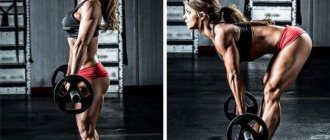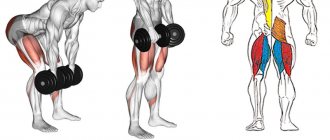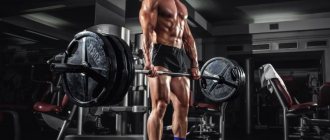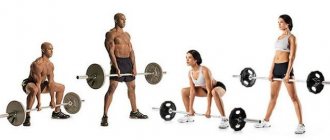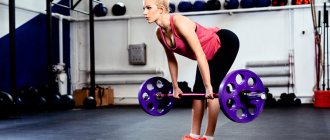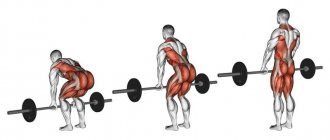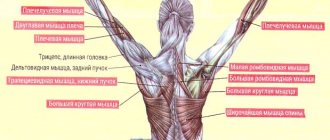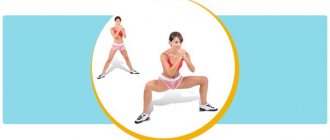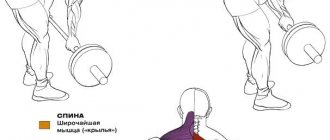The sumo deadlift gets its name from its wide stance. This is a lifting technique for lifting a barbell from the floor. Powerlifting differs from bodybuilding in its main goal. In the first case, you need to lift the greatest weight (emphasis on developing strength), and in the second, you need to work out the muscles efficiently, achieving their maximum growth (emphasis on shape and volume). The sumo-style deadlift technique is designed specifically for lifting maximum weight, but nevertheless it can also be useful for pumping up the muscles of the back and legs.
Sumo or classic deadlift, which is better?
For beginners, it is better to use the classic version of the exercise due to the more natural position of the joints when performing. It is also well suited for short or overweight athletes.
Sumo-style deadlifts are better for tall athletes because they allow you to shorten the movement and thereby lift more weight.
Another feature is that in the classics the gluteal muscles are used more and the inner thighs are less, while in sumo, on the contrary, the buttocks work less and the inner thighs work more. If this is important to both of you, then draw appropriate conclusions.
But for general training and working out the muscles of the body, it is better to use different options at different stages of preparation.
I'm sure you've heard a lot of different names like Romanian deadlifts, sumo deadlifts, and sometimes people even ask what the difference is between a squat and a deadlift.
Over time, you will likely become comfortable with your current training program.
You know what to expect from lifting weights, how to perform them correctly, and how much you can do on each exercise.
However, constant changes in the training process, increasing or decreasing weight in the training program are important for many reasons.
- First, you keep shocking your muscles. Muscle stress is very important for developing both strength and size. Over time, your muscles become accustomed to performing certain movements. Once this happens, the impact on the muscles is greatly reduced. You no longer feel sore the morning after your workout, and the gains in strength and size fade away. Adding some movements and abandoning others forces the body to constantly expect a trick. And that means tone, which is essential in the world of weight training and strength building.
- Secondly, new movements always work the body a little differently.
Even if you replace one row with another, the movement will be slightly different, which will cause the muscle fibers to move slightly differently. Even these small changes force the muscles to rebuild and adapt to new types of loads, which leads to constant growth and improvement in strength, which you will not achieve by simply repeating the same movements every time you come to the gym.
It's for these reasons that we recommend looking into new deadlifting techniques that you haven't previously incorporated into your workouts, including the sumo deadlift.
Muscle work
Classic or sumo can be performed with the goal of lifting maximum weight. To do this, it is necessary to force the muscles to work in concert, and also to reduce the range of motion of the barbell.
The following muscle groups are involved in both variations of the deadlift:
- Buttocks and legs. These include: hamstrings, gluteal and adductor muscles. When performing sumo, the load on all these muscles will be an order of magnitude greater than with the classic version.
- Back. The deadlift works great on the lats, spinal extensors, and trapezius muscles. In this case, sumo puts less stress on these groups than classic.
- Forearms. They are always tense, since they are the ones who have the main task - keeping the projectile suspended.
What is a sumo deadlift?
The last word in the title should give you some thoughts about what you have to do.
In the classic deadlift, which you already do as part of your program, you have a barbell with plates in front of you.
You lower yourself almost into a squat, with your feet approximately shoulder-width apart, grab the barbell in front of you and keep your back straight. You then explosively yank the barbell upward, holding the barbell with your hands as your lower body pushes you upward. This important exercise works almost the entire lower half of the torso, in addition to this, the lower back is involved and, depending on how you hold your shoulders, the trapezius can also be captured.
The sumo deadlift is similar to the regular deadlift in many ways.
The only difference, at a minimum, is that the technique of performing a sumo deadlift involves a special positioning of the legs.
This is where the name traction comes from. Imagine a sumo wrestler getting ready to throw. Most likely it will be an image of a very large Japanese man in a vanishingly small amount of clothing, with his legs spread very wide, as if he specifically wanted to show how little he was wearing. It is the width of the stance that forms the basis of the sumo deadlift. The spread of the feet is what changes. You need to place your feet much further than shoulder-width apart and turn your hips outward.
From this position, the movement is performed in the same way as any other deadlift.
Proper Deadlift Technique
Sumo-style deadlifts are probably not something you do often in the gym. Although, of course, there are gyms where you rarely see anyone doing a deadlift at all.
However, if you are already more or less accustomed to traditional deadlifts, performing this variation will not be difficult for you.
By changing the position of your legs, you shift the emphasis in the muscles involved (more on this later). In order to complete it, you will have to pay close attention to the scales. When you do this deadlift variation for the first time, it's best to unload the bar slightly to get a feel for how your body reacts.
Stand in front of a barbell with a weight loaded on it. Place your feet significantly wider than your shoulders. You will most likely feel some tension on the inside of your thighs. If you have not previously stretched and warmed up this part of the body, now is the time to do so. You can even do a few unweighted squats in this position before you start, just to activate the right muscles.
Grasp the barbell, keeping your back flat and straight.
In order to grab the barbell, you will have to bend at the waist. The grip will be the same as with a regular deadlift, that is, approximately shoulder-width apart. However, depending on your preferences, various small variations are acceptable. We accept an overhand, underhand, and different grip. Experiment freely to see what works best for you.
Lower yourself, bending your body slightly.
Due to the wide stance of the legs, the thighs will be almost parallel to the floor. Make sure you are looking forward, chest out, and back completely straight. The main weight will fall on the back of the legs. Expand with an explosive movement, pushing off with your legs. You hold onto the bar and your lower body does all the pushing up.
When the bar passes the line of your knees, push your pelvis forward, at this time bringing your shoulder blades together. This adds elasticity to the shoulder girdle. To increase the load and further work your shoulders, hold your shoulder blades together for a while before returning to the starting position. Make sure you have the correct body position as the barbell lowers down, then repeat. Compliance with all the nuances is very important.
Purpose of sumo deadlift
You're essentially doing the same movement as a traditional deadlift.
So why might you need to change anything?
It's all about foot placement and how it results in shortening the distance the weight is lifted. By rotating your hips outward, you put more stress on your hamstrings. A narrower stance distributes the weight throughout your hips, glutes, calves, and even quads. In this case, it falls almost entirely on the hamstrings. This makes the sumo deadlift one of the best exercises for this area imaginable (especially when combined with the sumo squat).
You also engage your hamstrings in a completely different way than most lower body exercises. Since you are standing in the same stance as a hamstring exercise, this is obviously how you are engaging the muscles. The sumo deadlift works the biceps and inner thighs. Thus, it allows you to load not only the area immediately under the buttocks, but also along the entire length of the legs.
By strengthening your inner thigh muscles, you will improve your technical performance in all exercises that involve your lower body.
Classic
Finally, it's time to figure out which is better - sumo deadlift or classic? To do this, you should consider the features of each type of exercise. First, it is better to pay attention to the classics, since they are familiar to both beginners and experienced athletes.
As mentioned above, the traditional version puts more strain on the back muscles. It has to be tilted more, due to which the entire top works. In addition, in this case you will not need to bend your legs much, since the main load should not fall on them. There is also one important point in the execution technique - the feet should be parallel to each other. Although some trainers recommend spreading your toes out a little, this is not necessary. In conclusion, it should be noted that there is a large amplitude of movement, since almost all parts of the body move out of the starting position.
What muscles work in the sumo deadlift?
The traditional deadlift is a classic and one of the best, if not the best, deadlift exercises out there. This is because it works almost every muscle group in the back of the body. Therefore, it should also not be sent to the bench in favor of another exercise. However, you can (and I think you should) add sumo deadlifts to your rowing exercises. Just like a regular one, it uses a large number of muscles in the back of the body.
The target muscle groups in this case are the hamstrings and gluteal muscles. You work this area (especially the tendons) more than with a regular deadlift due to the wide stance.
The abductor muscles are also well worked out. It also works the quadriceps, although this greatly depends on how wide you can spread your legs. And when deadlifting, your forearms also strain, but this is quite obvious, because although the legs do the main work, you still hold the weight with your hands.
As for the secondary muscles, almost the entire back is involved. Thanks to the retraction of the shoulder blades, which you perform at the top of the row, your trapezius receives its portion of the load. Additional stabilizing muscles for this particular deadlift include the hip flexors, abs, and rhomboids.
Effectiveness factors
The most important factor that determines how effective the deadlift will be is the execution technique. The videos will help you understand the main points of this exercise, but ideally it is better to seek help from a professional instructor. A specialist will help you understand all the important nuances and develop the technique. Having mastered the rules of performing deadlifts, in the future you will be able to successfully practice on your own. This is extremely important, as performing the deadlift incorrectly can lead to serious injury. Among the gross mistakes that beginners usually make are the following:
- back bending. Throughout the entire execution process, the back should remain straight. Bending is the path to sprains, dislocations of the vertebrae and the formation of an intervertebral hernia;
- falling back. At the top point you cannot lean back. This creates an increased load on the lower back, which can cause pinched nerves, the formation of hernias, and compression fractures;
- different grip. This feature is characteristic of the sumo technique. But you shouldn’t use it too often, as it causes over-tension of the shoulder joints and biceps ligaments.
People with dysfunctions of the musculoskeletal system, scoliosis, intervertebral hernias, compressions, protrusions, problems with joints, heart, and blood vessels should not engage in deadlifting.
Who should do sumo deadlifts?
This is truly a great deadlift variation that everyone should at least try.
Of course, if you spend time in the gym practicing all the deadlift techniques, you can stay there. Sumo deadlifts can be added to a routine along with regular deadlifts, or done periodically in place of them, changing them every few weeks to continue to surprise the muscles in your lower body (and to keep your workouts from getting boring with monotony).
As for who should do sumo deadlifts instead of regular ones, it all comes down to the traumatic nature of the exercise. The sumo deadlift places much less strain on the lower back and spine.
So if you suffer from back pain or have had an injury to the area, switching to sumo deadlifts will give you the ability to perform the exercise without putting your back at risk.
Exercise in Smith
Classic or sumo are performed freely in the Smith machine. This option appeals to many people, as it has many advantages:
- choice of projectile level;
- fixation of working weight;
- vertical stroke of the bar, which is especially good for beginners for whom it is important to understand the technique;
- no need to load the body in terms of stabilization.
Working on a Smith machine is not as difficult as it seems at first glance. When removing the bar, you must immediately turn it. Warm-up should be performed only with an empty apparatus, which applies not only to beginners, but also to experienced athletes.
This method of training is not suitable for people who are initially focused on powerlifting. This is explained by the fact that in this area athletes work only with free weights, so there is simply no point in training on Smith.
Experienced athletes strongly recommend that beginners try both deadlift techniques on this machine. They argue that this is the only way to understand which option is better. At first, you can experiment a little, but after a few weeks of practice you will already have a good idea of the exercise and its benefits.
Example workout
As with most powerlifting movements, it all depends on whether you want to work for strength or size.
If this is your first time doing the exercise, be sure to start with a light weight.
Even if you're a seasoned lifter, shifting your focus takes time for your muscles to adapt, so you likely won't be able to lift heavy weights right away.
If your goal is strength, do 3 sets of 4 reps . There are likely many more pulling exercises in your later program, so once you complete this deadlift, stop and move on to the next one. However, if time is pressing or you end the program with sumo deadlifts, add an additional fourth set, but use a lighter weight for it and do 12 reps.
This can help burn off any remaining energy and push your lower body muscles to the point of failure.
If you just want to build muscle and not increase strength, do eight to 12 repetitions.
If you can do 12 reps without difficulty, you need to increase the weight. 9 or 10 reps is your benchmark. Do three sets and increase the weight each time if you did 12 reps before. You need to bring the body to a state of muscle failure. If you've done 12 and can still lift weights, then you're not getting the full benefit out of the exercise.
